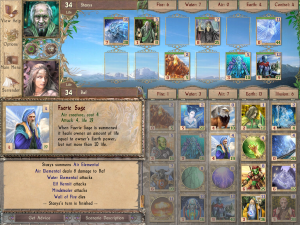Spectromancer: Mechanics in Detail
 Spectromancer gives you a random assortment of 20 spells in each match, in a grid of four levels and five elements. The levels just correspond to increasing power and mana costs, and in the single-player campaign mode, you don’t have access to the fourth level at first. The elements are fire, water, air, earth, and a specialty that varies with the character — possible specialties include Cleric, Illusionist, Mechanist, and a few others. Each element has its own mana, which builds up at a constant rate of 1 unit per turn, unless altered by magical effects: certain creatures aid you by accumulating mana faster, and at least one creature decreases it for the opponent. This is a mechanic that would probably be unwieldy in an actual card game, but it’s fine when a computer is keeping track of it.
Spectromancer gives you a random assortment of 20 spells in each match, in a grid of four levels and five elements. The levels just correspond to increasing power and mana costs, and in the single-player campaign mode, you don’t have access to the fourth level at first. The elements are fire, water, air, earth, and a specialty that varies with the character — possible specialties include Cleric, Illusionist, Mechanist, and a few others. Each element has its own mana, which builds up at a constant rate of 1 unit per turn, unless altered by magical effects: certain creatures aid you by accumulating mana faster, and at least one creature decreases it for the opponent. This is a mechanic that would probably be unwieldy in an actual card game, but it’s fine when a computer is keeping track of it.
Note that I describe continuing magical effects as properties of creatures. That’s because summoning spells are the only continuing effects in the game. Anything that isn’t a summon is an instant. This is one of the game’s the most severe bits of streamlining. The effect on the design is that things that would be enchantments in a more M:tG-like system are instead things with hit points, and have to be put on the board, where they can be attacked and destroyed.
The board consists of six columns and two rows, one row for each player. When you summon a creature, you choose a column, and for the most part, it doesn’t move from there. This placement takes the place of assigning blockers. When your creatures attack — which they do every turn, with no option of holding them back — they’re blocked by the opposing creature in the same column. I remember seeing a CCG prototype with a similar board mechanic a number of years ago. For all I know, it may be commonplace in the more advanced sort of CCG, but I thought at the time that adding a board to a CCG seemed overly elaborate, too rules-heavy. The difference is that in a tabletop game, you have to read and understand the rules (if not their implications) before you can even begin playing. In Spectromancer, you can just play and learn the rules by observation. The ordering of the columns is usually unimportant, but some creatures have effects on the adjacent columns, which is the closest this game gets to a targeted enchantment. Also, combat gets resolved from left to right, which, in rare cases, can be important: if you kill a creature with a global effect, the combat in the remainder of the columns is resolved without that effect.
Combat is done in a similar manner to M:tG, but with one important difference: creatures have hit points, which persist from round to round. The middling-hardy creatures are effectively impossible to kill in a single turn, and have to be killed by degrees, which means that their owner is guaranteed at least one turn of whatever effects they have.
 Comments(0)
Comments(0)